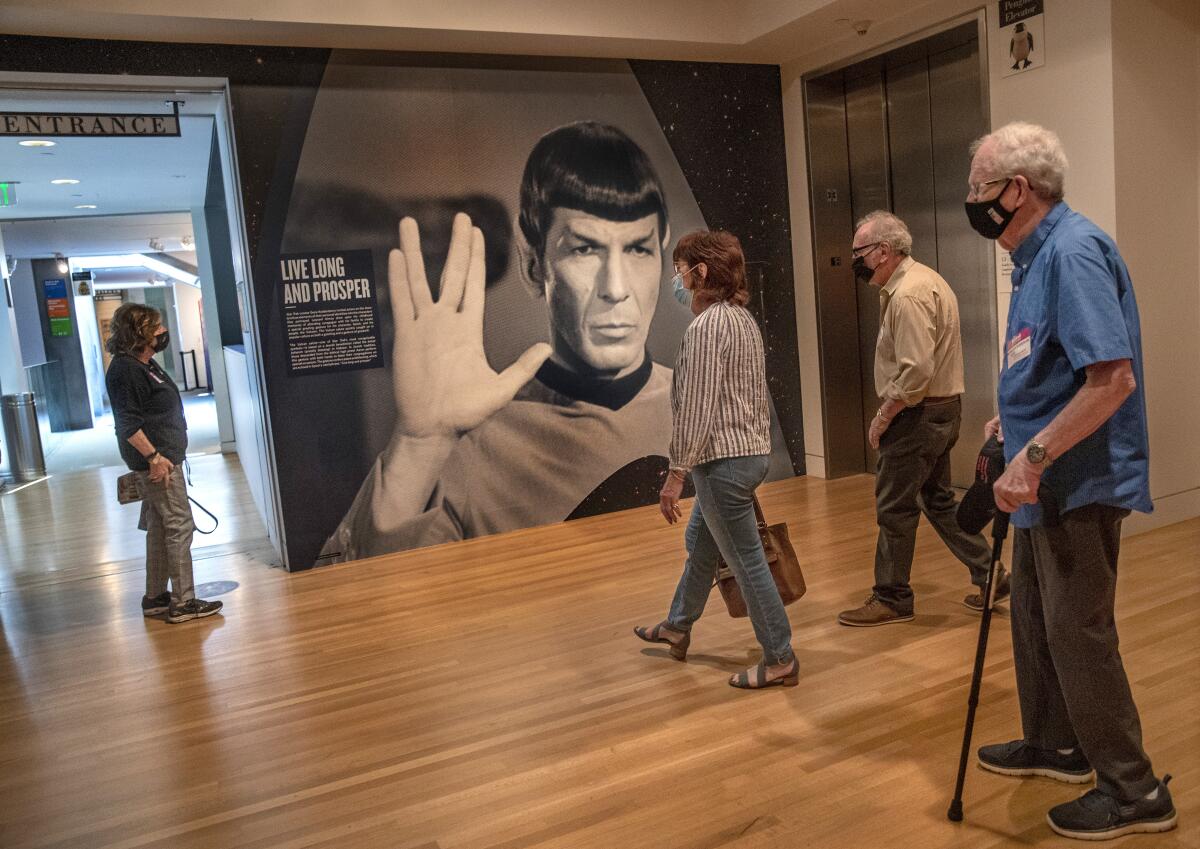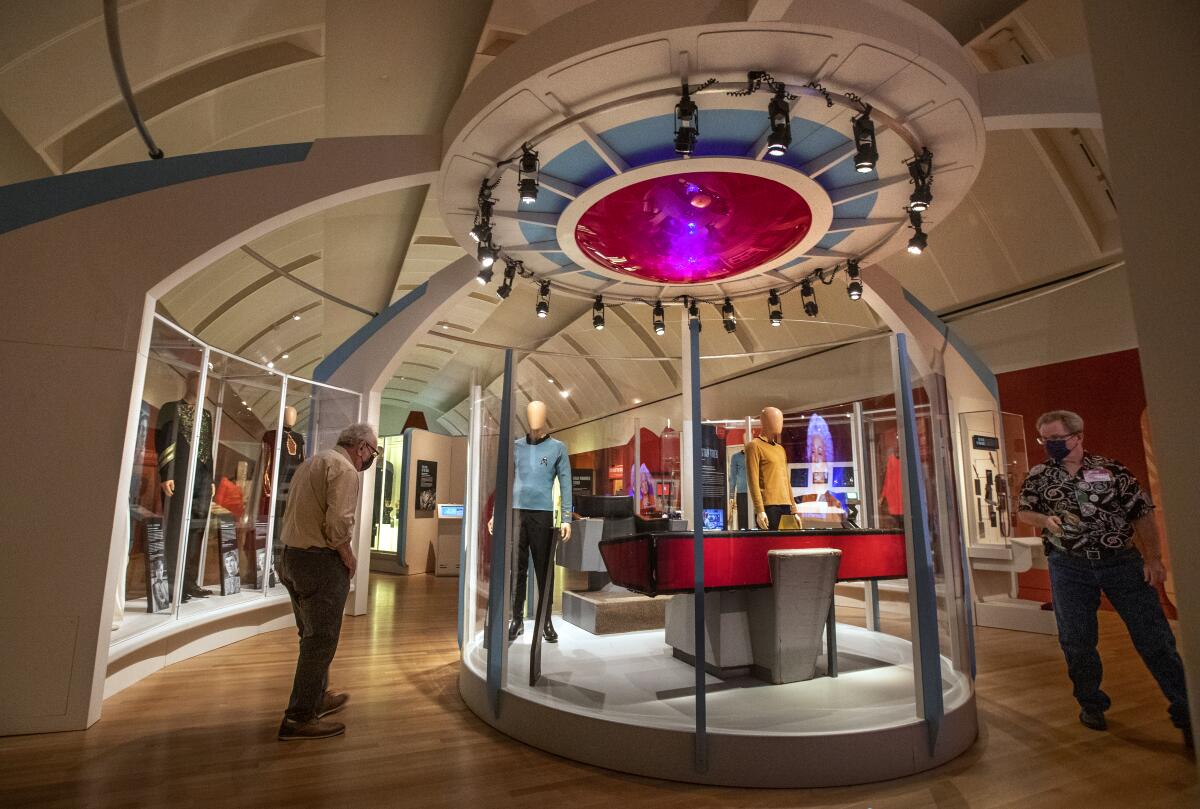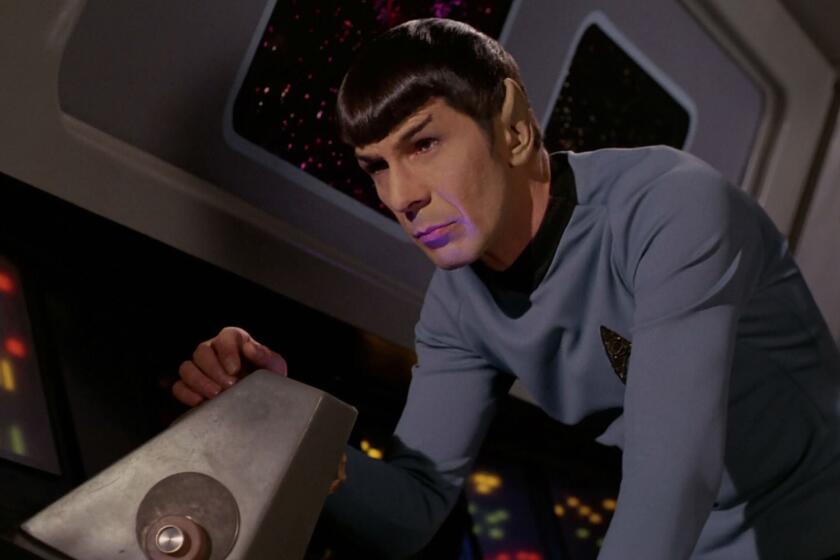Exhibit finds the Skirball and ‘Star Trek’ on common ground

- Share via
Welcome the stranger. Honor memory. Seek learning. Pursue justice. Build community. Show kindness. These are the continuing missions of the Skirball Cultural Center. As it happens, they’re also pretty much the mission of an old, continuing science-fiction series.
The two worlds come together with the center’s newest exhibit, “Star Trek: Exploring New Worlds,” which opens at the Skirball on Oct. 7. The show includes everything from original costumes and ship consoles to an interactive station where you can “build your own episode.”
At first blush, a Jewish museum mounting a “Star Trek” exhibit might seem random. Aside from a new video introduction for the Skirball, the connection isn’t explicit because this touring gallery originated at Seattle’s MoPOP museum in 2016. But the Jewish themes and values — not to mention creatives and cast — in this expansive universe of TV shows and films have been a rich field of study for the 55 years since the original series premiered.
In their stated mission “to boldly go where no man has gone before,” Captain Kirk and his multiracial team of scientists, doctors and engineers were a space-flung diaspora representing the United Federation of Planets in a future when humanity had set aside its differences. The crew visited other planets with a “Prime Directive” to discover without doing injury, and they encountered alien societies struggling with very human dilemmas and conflicts.
Dozens of news articles (“Was ‘Star Trek: The Next Generation’ ... a statement on Jewish identity?”), as well as dissertations (“Golem as Metaphor”), podcasts (“Star Trek and the Jews”) and even other exhibitions (“Jews in Space”) have explored the common threads. Trekker rabbis have even offered courses to their congregations.
The stars of the original series, Leonard Nimoy and William Shatner, were both sons of Ukrainian Jewish immigrants. Both grew up in kosher homes, and both were taunted by anti-Semitic slurs growing up.
“Experiences like that create a sort of subtext,” Shatner wrote in “Leonard: My Fifty-Year Friendship With a Remarkable Man,” his 2016 book, “and as we got to know each other, those common experiences helped bind us together. It’s almost an emotional shorthand.”
Nimoy played the ultra-logical Spock, half-human, half-Vulcan — an alien caught between two worlds, never fully fitting in. “Trek” creator Gene Roddenberry let Nimoy shape the details of his character, and Nimoy famously came up with the Vulcan salute from a boyhood memory of sitting in a synagogue and seeing the hand gesture used by the Kohanim, or priests, as they blessed the congregation.
In 1966, when Leonard Nimoy was cast on a new science-fiction TV series called “Star Trek,” he was already 15 years deep into an acting career that had often appeared to be boldly going nowhere in particular.
Several writers on the original “Star Trek” series were Jewish — including the popular episode “The Trouble With Tribbles” scribe David Gerrold — and the show tackled topics like racism and the Holocaust in both veiled and explicit ways. When Nimoy was asked in 2001 about the fundamental Jewish themes in “Star Trek,” he answered with a list: “Social justice, meritocracy and the idea of tikkun olam — the healing of the universe.”

The dream of healing is very much on the mind of the Skirball’s new CEO. Jessie Kornberg joined the center in July 2020 — after founder Uri D. Hescher retired — months after the “Star Trek” exhibition had been procured. Then, mere days before it was scheduled to open, the center shut down because of the pandemic.
“That layer feels really relevant to me right now as we are all trying to find our way through and out of this pandemic,” said Kornberg, noting how Roddenberry was a combat veteran who envisioned his utopian future in the wake of World War II and amid the social upheaval of the 1960s.
“This has felt to me like a World War II-type global event, right?” she added. “Deep trauma, incalculable loss, paradigmatic shift. And I hope that, as with Skirball’s interpretation of Jewish history, and as with Roddenberry’s imagining of ‘Star Trek,’ that this moment too finds us all really reaching for a more inclusive future.”
“Exploring New Worlds,” set to continue through February, showcases set pieces and costumes from just about every “Star Trek” series and film, including Captain Kirk’s command chair and navigation console, Spock’s tunic and Captain Picard’s uniform, tricorders, a Borg cube and, of course, Tribbles. There are also original scripts, concept art and spaceship models — along with interactive video screens and text placards full of history and trivia.
Screenings of “Star Trek II: The Wrath of Khan” and curated TV episodes also are on the calendar, with special guests including Gerrold and Brent Spiner, who plays Data in “The Next Generation” and “Picard.”
You won’t find trivia such as how many subsequent “Star Trek” creators, directors and showrunners have been Jewish (“Wrath of Khan” director Nicholas Meyer attended new “Trek” director J.J. Abrams’ bar mitzvah). And you won’t find less comfortable history like Roddenberry’s anti-religious stance or how the fictional Ferengi arguably perpetuated anti-Semitic stereotypes.
Even though the exhibition doesn’t directly draw attention to the Jewish themes in “Star Trek,” Kornberg hopes visitors will absorb them in the context of the rest of the center — including the permanent exhibit “Visions and Values,” which is open for the first time since the shutdown.
That collection, she said, “presents our interpretation of 4,000 years of Jewish history and heritage and really highlights those values that we think are most important to that history and are in common with the values espoused in the ‘Star Trek’ universe.”
There’s also “Sustain: From Loss to Renewal,” a new exhibition in response to the past year and a half, which has invited visitors to light a memorial yahrzeit candle or leave a stone at a gravesite to honor the memory of someone lost. Visitors can view portraits of frontline and essential workers and other community members deeply affected by the pandemic.
“All of this, for us, is really built on this Jewish value of honoring memory,” Kornberg said, “and building on long-held Jewish traditions and rituals to hopefully bring a sense of shared experience, community building and hopefully comfort to our visitors as they come back into a cultural space, maybe for the first time in a long time.”
Jessie Kornberg, noted for her pursuit of social justice and regard for the immigrant experience, takes over as Skirball president and chief executive in July.
Kornberg cops to being unfamiliar with “Star Trek” before she assumed the captain’s chair at the Skirball, but she’s been impressed by the Trekkers who revealed themselves to her because of this exhibition. The running themes among fans, she’s observed, are an appreciation for teamwork rather than individualism — and hope.
“There’s a sense of optimism that is actually, I think, in too rare supply these days,” she said, “and is always a thread in any conversation I have with a ‘Star Trek’ fan. So that’s just wonderful and something that obviously we want to encourage more of at Skirball.”
'Star Trek: Exploring New Worlds'
Where: Skirball Cultural Center, 2701 N. Sepulveda Blvd., Los Angeles
When: Weekdays noon-3 p.m. and weekends 10 a.m.-3 p.m. through Feb. 20
Tickets: Advance reservations required, $13-$18; free on Thursdays, and free to members and ages 2 and younger
Info: skirball.org/visit
More to Read
The biggest entertainment stories
Get our big stories about Hollywood, film, television, music, arts, culture and more right in your inbox as soon as they publish.
You may occasionally receive promotional content from the Los Angeles Times.











